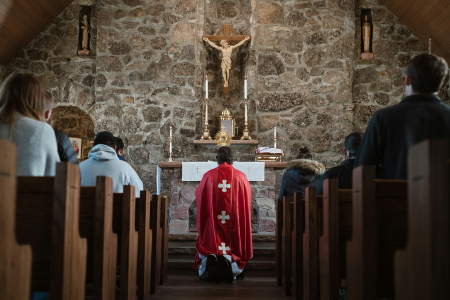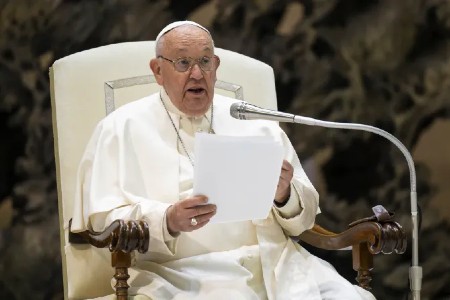Gaboon
FREE Catholic Classes
V ICARIATE A POSTOLIC OF G ABUN
Formerly called the Vicariate Apostolic of the Two Guineas . The name Gaboon (Gabão) was originally given by the Portuguese to the estuary on which stands the town of Libreville, and to a narrow strip of territory on either bank of this arm of the sea. In the days of the slave trade it was merely a trading station on the Coast of Guinea which at that time extended from the Senegal to the mouth of the Congo River. At the present time the name of Guinea for this territory and the ecclesiastical title "The Two Guineas" have gone out of use both in the civil and the religious sense, and Gaboon designates the northern portion of French Congo, south of the Equator and lying between the Atlantic ocean and longitude 12 east of Paris. It is coextensive with the basin of the Ogowai River, to which should be added several small subsidiary streams as the Muni, the Komo, and the Rembo-Nkomi. Its surface though broken and uneven is at no point of great elevation, and is covered by a great dense, tropical forest interrupted only by some rocky plains in the south. The only roads are the tracks used by the natives, along which caravans travel on foot. The rivers are often blocked by rapids, so that navigation is both uncertain and hazardous. The climate is sultry, humid, and subject to storms, but the temperature remains almost stationary; the rainy season lasts from September to May. On the whole it is a healthy climate for men of temperate lives, and the mortality there is one of the lowest on the West-African coast. The population of Gaboon is very mixed, Gaboon being the geographical terminus of the migration drawn from the interior by trade. No doubt many of the races become broken up on the way, but those that reach the coast are slowly absorbed among the earlier settlers there. Indeed many of these tribes are semi-nomadic by habit, and change the sites of their villages as soon as the lands in their vicinity have become exhausted by crop-growing. It thus comes to that pass every four or five years a new ethnographical map of the country is necessary.
However it is possible to divide the peoples into several groups. Under the first group may be included the old slave-trading races that have been established a long time on the Coast. Of these the most important people are the Mpongwe, dwelling along the Gaboon estuary; they are mentioned in the eighteenth century by Dutch navigators. As a race they are intelligent and keen and enjoy an undoubted ascendancy over the other black races. They are, moreover, gentle and hospitable, too hospitable perhaps. They easily fall victims to European vices, and immorality and alcohol have almost wiped them out. Not more than a few hundred of them remain, many of whom go as traders far into the interior. The point of the Gaboon peninsula is occupied by the Bengas; the creeks or inlets of the Manda and the Muni by the Baseki, usually known as the Boulous (Bulu); both tribes live by fishing and are dying out from alcoholism. Their languages differ from each other and equally from that of the Mpongwe. However the three tribes settled towards the South in the delta of the Ogowai, the Orongous (Orongu), the Galoas, and the Nkomis use a slightly modified form of Mpongwe, follow the same customs, have the same vices as the Mpongwe of the estuary, and engage in the rubber trade as well as in fishing. The second group is made up of one single tribe, the Fans or Pahouins (Pawin) who inhabit all the northern portion of Gaboon as far as the Ivindo, and in places are to be found along the left bank of the Ogowai. They are true barbarians and are an invading race, whose progress towards the coast goes on unceasingly.
They do not deserve all that former travellers have said as to their ferocity, but they are very fierce-looking, muscular, warlike, and above all vindictive. They are not, however, slave-dealers, nor do they, properly speaking, own slaves ; their wives are really their slaves, and polygamy is more in vogue and more bestial among them than elsewhere. Nevertheless they are not victims to the grosser forms of immorality, in the same measure as other tribes are, but along the great rivers and at the coast alcoholism works terrible havoc among them. Those of them who dwell in the interior still practise cannibalism on their prisoners of war.
A third group of peoples is to be found in the southern part of the country; in this territory live tribes still given over to slavery. Thus, for instance, the Esteiras and the Balkalai, who act as middlemen in trading with the tribes dwelling in the mountains, the Bayakas, Bapunus, Ndjavis, Ishogos, Mbétés, Shakés, Adumas, who in exchange for articles of commerce sell their children as slaves. These slaves are brought secretly to the coast, but are no longer shipped to the Antilles or Brazil, instead they are bought by the Mpongwe and Nkomis who are thus enabled to lead lives of idleness. All these groups of tribes practise fetichism. They believe in a God who made the world, in an immortal soul and in retribution for evil ; they worship spirits and ghosts, and are under the sway of sorcerers and secret societies, to which even the authority of their chiefs must yield.
The early evangelization of the country by Capuchins from Italy left no permanent traces. About 1840 an American prelate, Monsignor Barron, was the first to answer the appeal made for a priest of the Catholics among the freed negroes that the United States Government had shipped back to the coast of Africa. Monsignor Barren gave up an important post which he held under the Archbishop of Philadelphia and made two voyages to the Guinea Coast between 1840 and 1843. The Venerable Père Libermann had just at this date founded at Amiens his new congregation of the Sacred Heart of Mary, which later was united with that of the Holy Ghost ; he furnished the first missionaries to Monsignor Barren. In the first year six out of seven of the missionaries died as much of starvation as of sickness; the seventh, after increditable adventures, succeeded in reaching Cape Palm on the Gaboon. This was Père Bessieux and the date, 29 September, 1884. The French navy had set up a small fort there intended as a lookout for vessels engaged in the slave trade, and consequently Père Bessieux was able to erect the first station at this spot. The following year brought him many helpers, and among them Père Le Berre. In 1848 a slave dhow was captured by the French and forty-nine slaves were located near the mission station on a little plateau which was thereupon called Libreville (Freetown). Père Le Berre was given the official title of "Professor of Morals " and began instructing them. The next year the first nuns arrived, the French Sisters of the Immaculate Conception. In 1849 Père Bessieux was recalled to Europe, consecrated bishop, and sent back to Gaboon as Vicar Apostolic of the Two Guineas, with jurisdiction over a coast line 2000 leagues long, where today there are twenty-five ecclesiastical divisions.
About this time the Libreville mission made many attempts to set up stations elsewhere; only one was a success, that among the Bengas of Cape Esteiras, and it was called St. Joseph's Mission. To-day nearly all of this small tribe are Catholics. While the Libreville mission was in process of organization, building a suitable church, enlarging its schools, and clearing its grounds, the little government station about a mile away was gradually becoming a small town. In 1860 it became necessary to erect a parish there, and thus was founded the mission of Saint-Pierre, having for special object the conversion of the Mpongwe. The work of the sisters was transferred to this place as well as the school for girls and a native hospital ; later the colony built a church and at present the parish contains about 3000 faithful. Monsignor Bessieux died in 1876 after having spent 33 years in Africa ; he was succeeded by his early companion, Monsignor Le Berre. Under the new bishop new stations were rapidly founded, and the Congregation of the Holy Ghost continued to supply the necessary missionaries. In 1879 a mission to the Pahouins of the Como was attempted for the first time, and the Station of Saint Paul de Donghila was opened; after great hardships it is now a flourishing mission counting more than 1000 Catholics. Soon afterwards the missionaries began to move inwards from the coast and the estuary and in 1881 the mission of Saint-François-Xavier was founded at Lambarene on the Ogowai; in 1883 that of Saint-Pierre-Claver among the Adumas, which was afterwards moved to Franceville near the source of that river. In 1886 at Fernando Vaz in the Nkomi country the mission of Sainte-Anne was organized. These three places are now great mission centres and are thoroughly equipped. It would be only fitting to add to this list Monsignor Le Berre's new stations in the Kamerun sad in Spanish Guinea; but they now form part of new ecclesiastical divisions. In 1891, after 45 years of missionary life, the holy bishop died. His works had increased tenfold and his memory is blessed. He was succeeded by Monsignor Le Roy. During the three years which the new bishop spent at Gaboon three new stations were created. One arose on the banks of the Rio Muni, first at Kogo, then at Butika, at the present frontier of Spanish Guinea, among the Fans of the north. Another was established below the first rapids of the Ogowai, also in the Fan country. This station was Saint-Michel of Ndjole. The third station, Sainte-Croix, is surrounded by the Esteira peoples of the south-west. At the same time a fresh impulse was given to the evangelizing movement, for this was the period of the principal labour on the languages, of translations, of relations, of very useful journeys of exploration, of ordinances favouring the work of the catechists, of agreements with the tribes concerning the reform of their family customs, etc.
We ask you, humbly: don't scroll away.
Hi readers, it seems you use Catholic Online a lot; that's great! It's a little awkward to ask, but we need your help. If you have already donated, we sincerely thank you. We're not salespeople, but we depend on donations averaging $14.76 and fewer than 1% of readers give. If you donate just $5.00, the price of your coffee, Catholic Online School could keep thriving. Thank you.Help Now >
The active direction of Monsignor Le Roy ceased in 1896 when he was elected Superior General of the Fathers of the Holy Ghost . He was replaced at Gaboon by Monsignor Adam, the present bishop, who has established three new stations: Notre-Dame-des-Trois-Epis, at Samba on the Ngume, a tributary of the left bank of the Ogowai, and Saint-Martin, a little further up the same river, both of them in the midst of the mixed populations of the south. The third post, of quite recent foundation, is Okano near Boue on the Ogowai in the Fan country. More than two hundred missionaries have died in the Gaboon territory and a hundred continue the work. They are divided into priests, brothers, both lay and teaching, and nuns. There are 47 priests ; native priests and seminarians, native brothers and sisters, and upwards of a hundred catechists aid in the work of evangelization, and the number of Catholics is more than 12,000. The moral gain is slow but evident; progress is always being made. There have been great obstacles to the spread of the Gospel, obstacles not always due to the barbarism, fetichism, slavery, and cannibalism of the pagan tribes.
Join the Movement
When you sign up below, you don't just join an email list - you're joining an entire movement for Free world class Catholic education.
-

-
Mysteries of the Rosary
-
St. Faustina Kowalska
-
Litany of the Blessed Virgin Mary
-
Saint of the Day for Wednesday, Oct 4th, 2023
-
Popular Saints
-
St. Francis of Assisi
-
Bible
-
Female / Women Saints
-
7 Morning Prayers you need to get your day started with God
-
Litany of the Blessed Virgin Mary
U.S. Catholic Parishes Experience Resurgence of Traditional Practices
-

Pope Francis Urges Faith and Prayers for Peace
-

Florida Welcomes Volunteer Chaplains to Public Schools
-
10 Fascinating Details About St. Joseph the Worker: Celebrating His Feast Day - May 1
-
St. Joseph the Worker: Model for Men, Young and Old
Daily Catholic
 Daily Readings for Thursday, May 02, 2024
Daily Readings for Thursday, May 02, 2024 St. Athanasius: Saint of the Day for Thursday, May 02, 2024
St. Athanasius: Saint of the Day for Thursday, May 02, 2024 The Our Father: Prayer of the Day for Thursday, May 02, 2024
The Our Father: Prayer of the Day for Thursday, May 02, 2024- Daily Readings for Wednesday, May 01, 2024
- St. Marculf: Saint of the Day for Wednesday, May 01, 2024
- To Saint Peregrine: Prayer of the Day for Wednesday, May 01, 2024
We ask you, humbly: don't scroll away.
Hi readers, it seems you use Catholic Online a lot; that's great! It's a little awkward to ask, but we need your help. If you have already donated, we sincerely thank you. We're not salespeople, but we depend on donations averaging $14.76 and fewer than 1% of readers give. If you donate just $5.00, the price of your coffee, Catholic Online School could keep thriving. Thank you.Help Now >
![]()
Copyright 2024 Catholic Online. All materials contained on this site, whether written, audible or visual are the exclusive property of Catholic Online and are protected under U.S. and International copyright laws, © Copyright 2024 Catholic Online. Any unauthorized use, without prior written consent of Catholic Online is strictly forbidden and prohibited.
Catholic Online is a Project of Your Catholic Voice Foundation, a Not-for-Profit Corporation. Your Catholic Voice Foundation has been granted a recognition of tax exemption under Section 501(c)(3) of the Internal Revenue Code. Federal Tax Identification Number: 81-0596847. Your gift is tax-deductible as allowed by law.










 Daily Readings for Thursday, May 02, 2024
Daily Readings for Thursday, May 02, 2024 St. Athanasius: Saint of the Day for Thursday, May 02, 2024
St. Athanasius: Saint of the Day for Thursday, May 02, 2024 The Our Father: Prayer of the Day for Thursday, May 02, 2024
The Our Father: Prayer of the Day for Thursday, May 02, 2024
